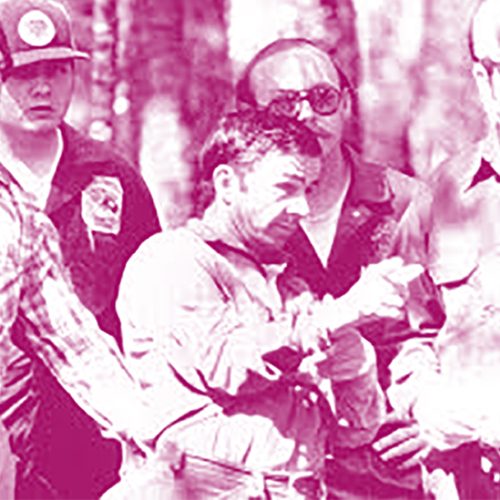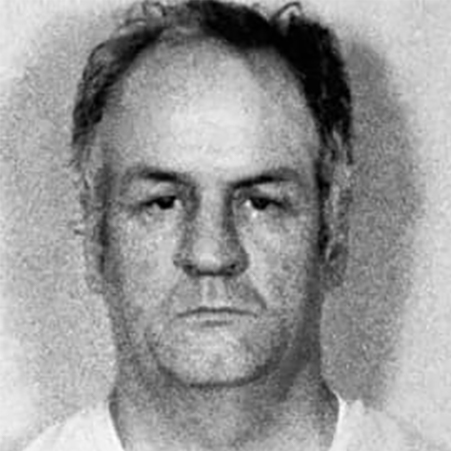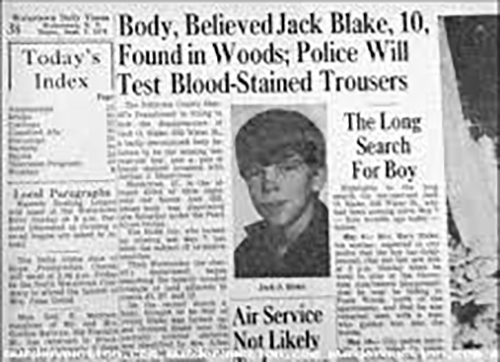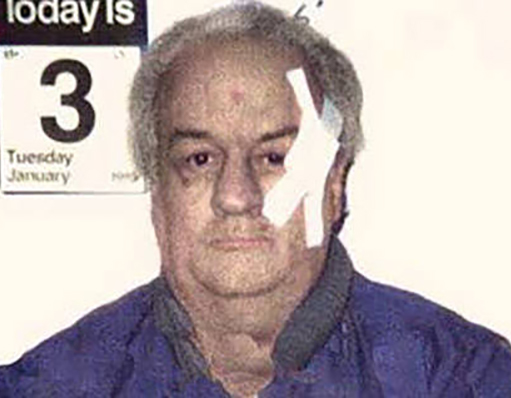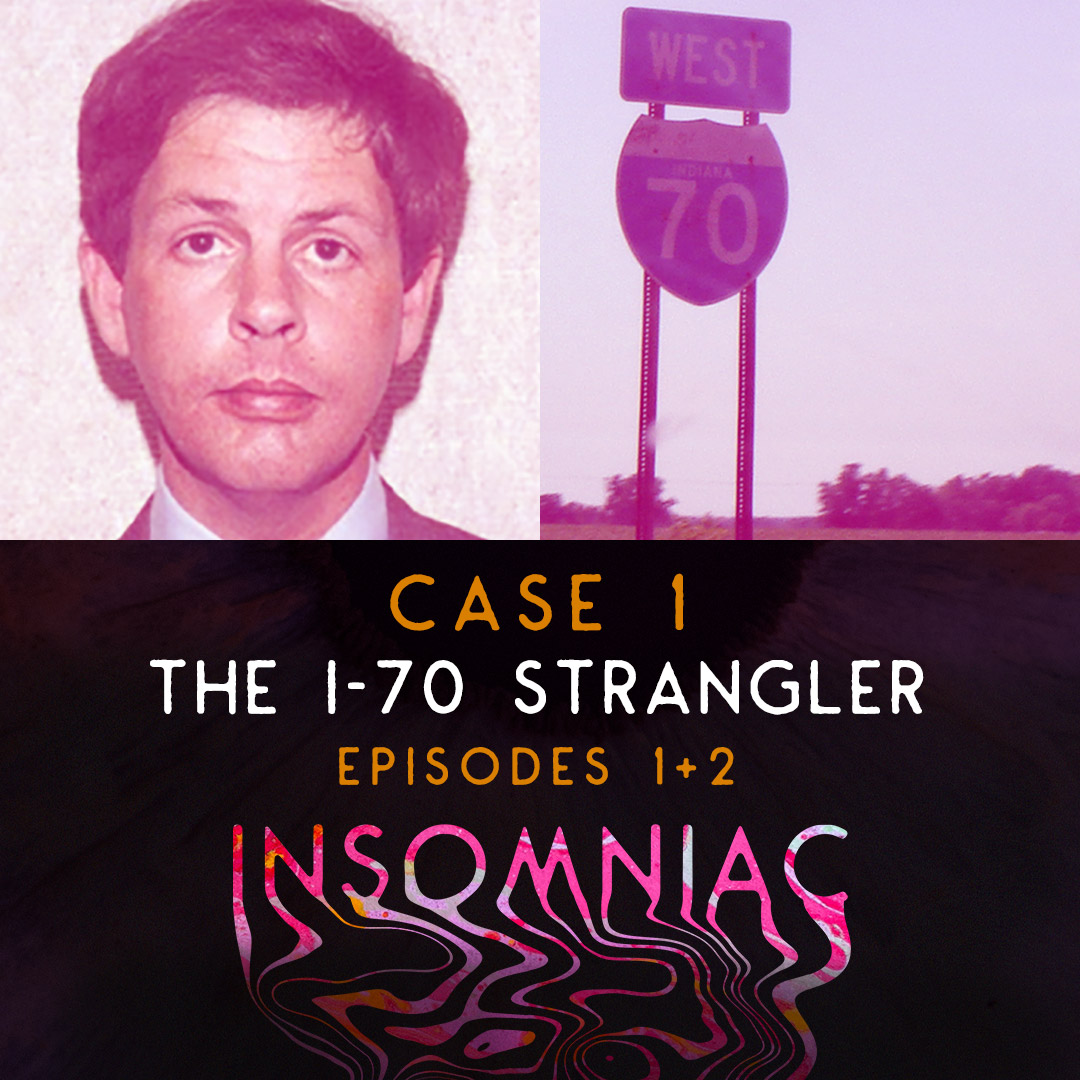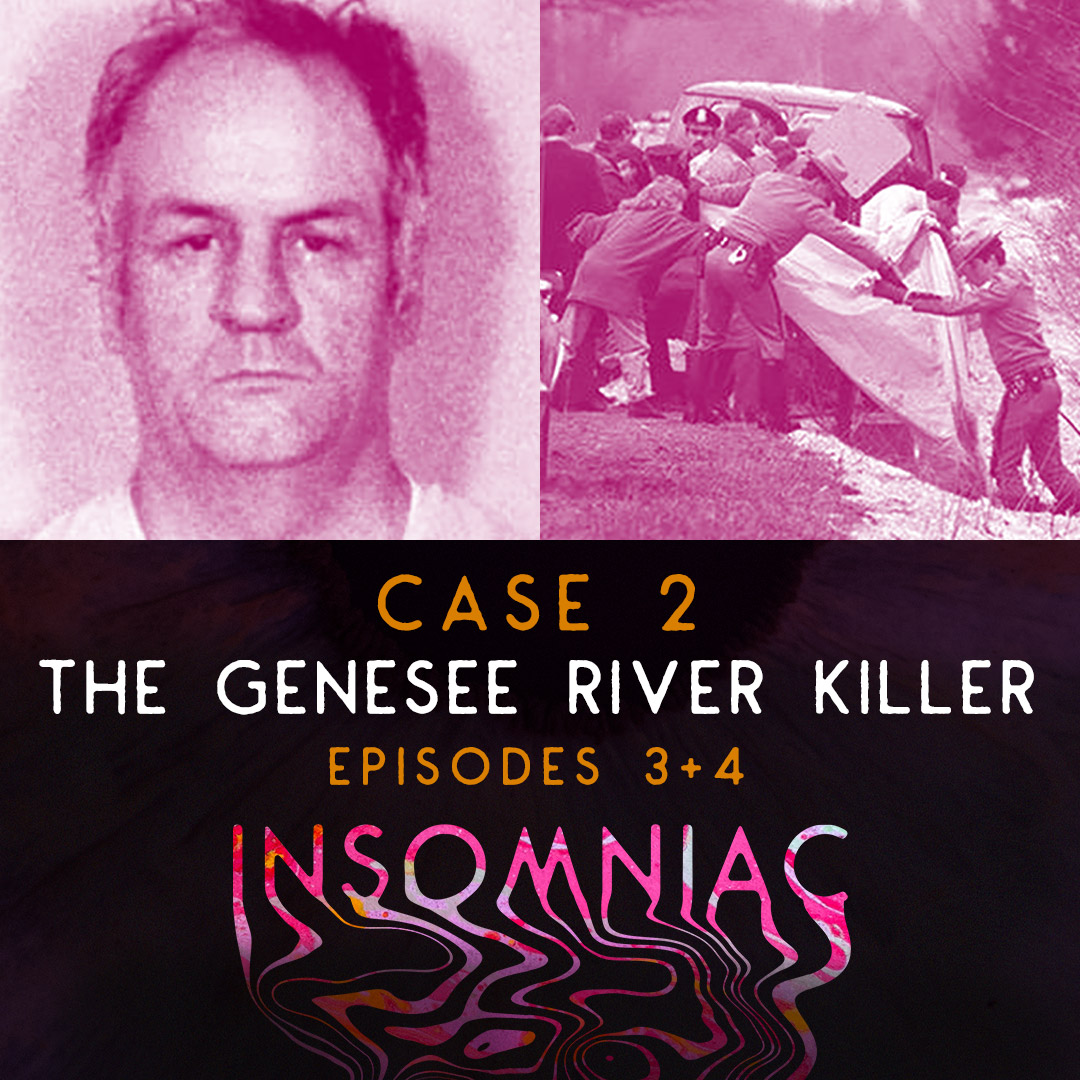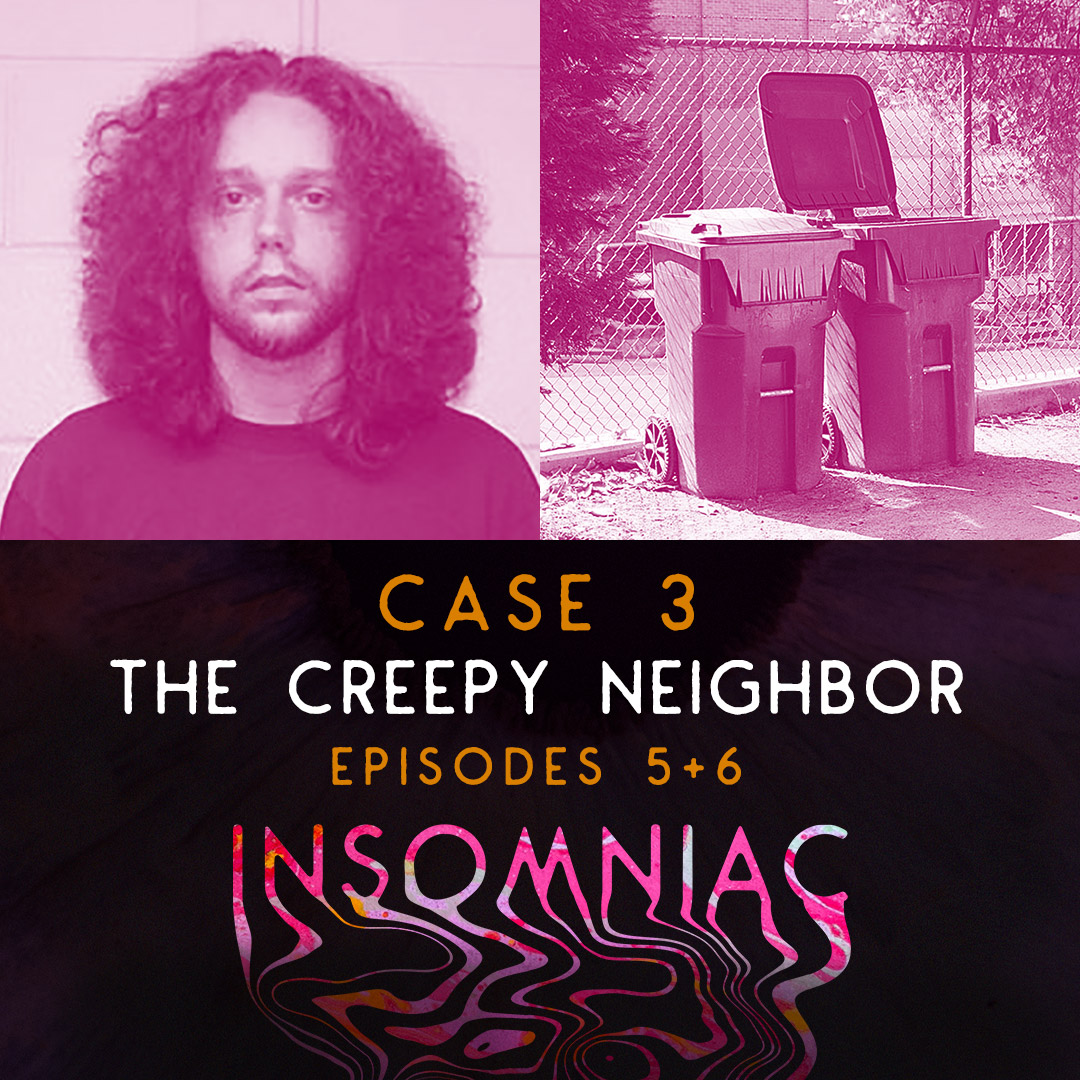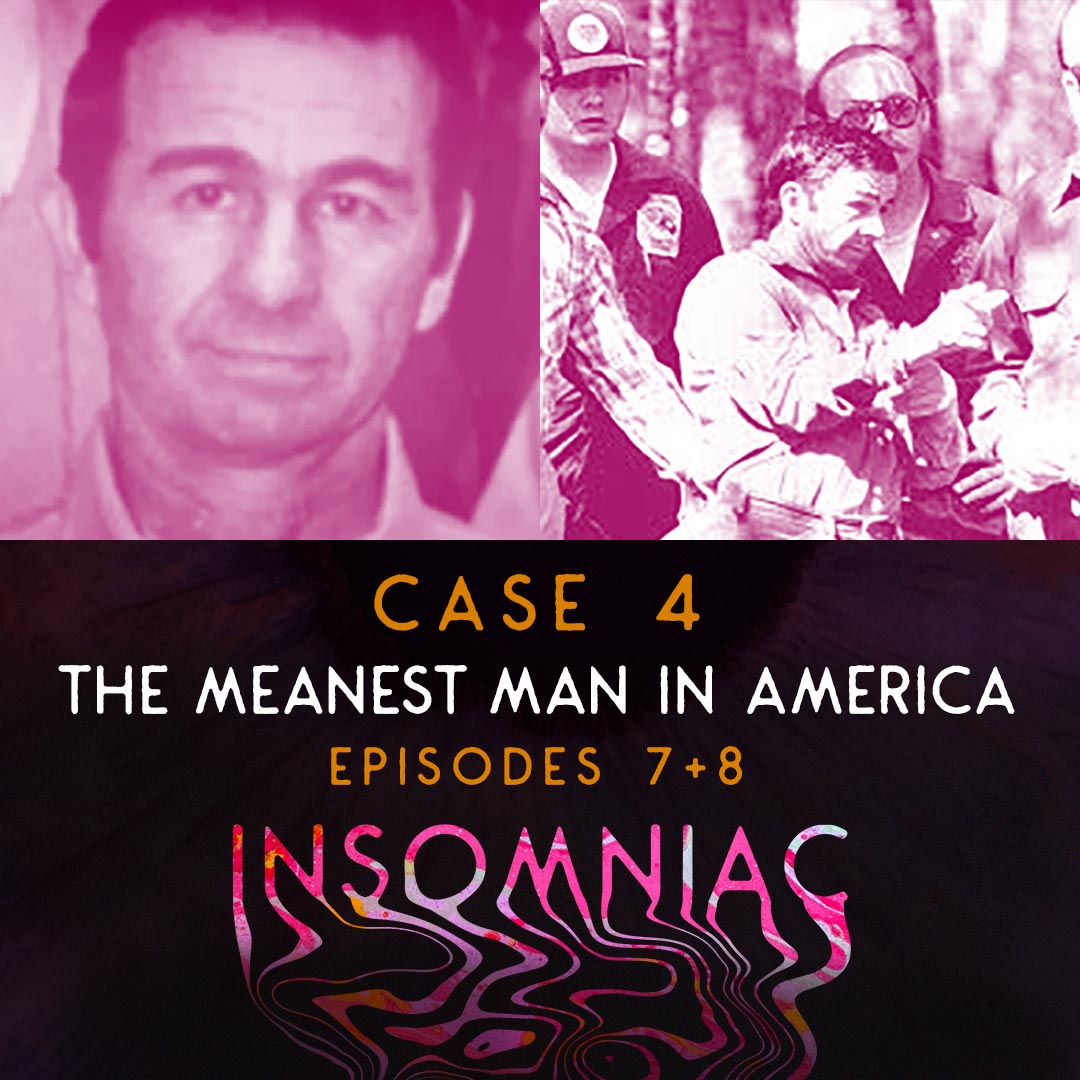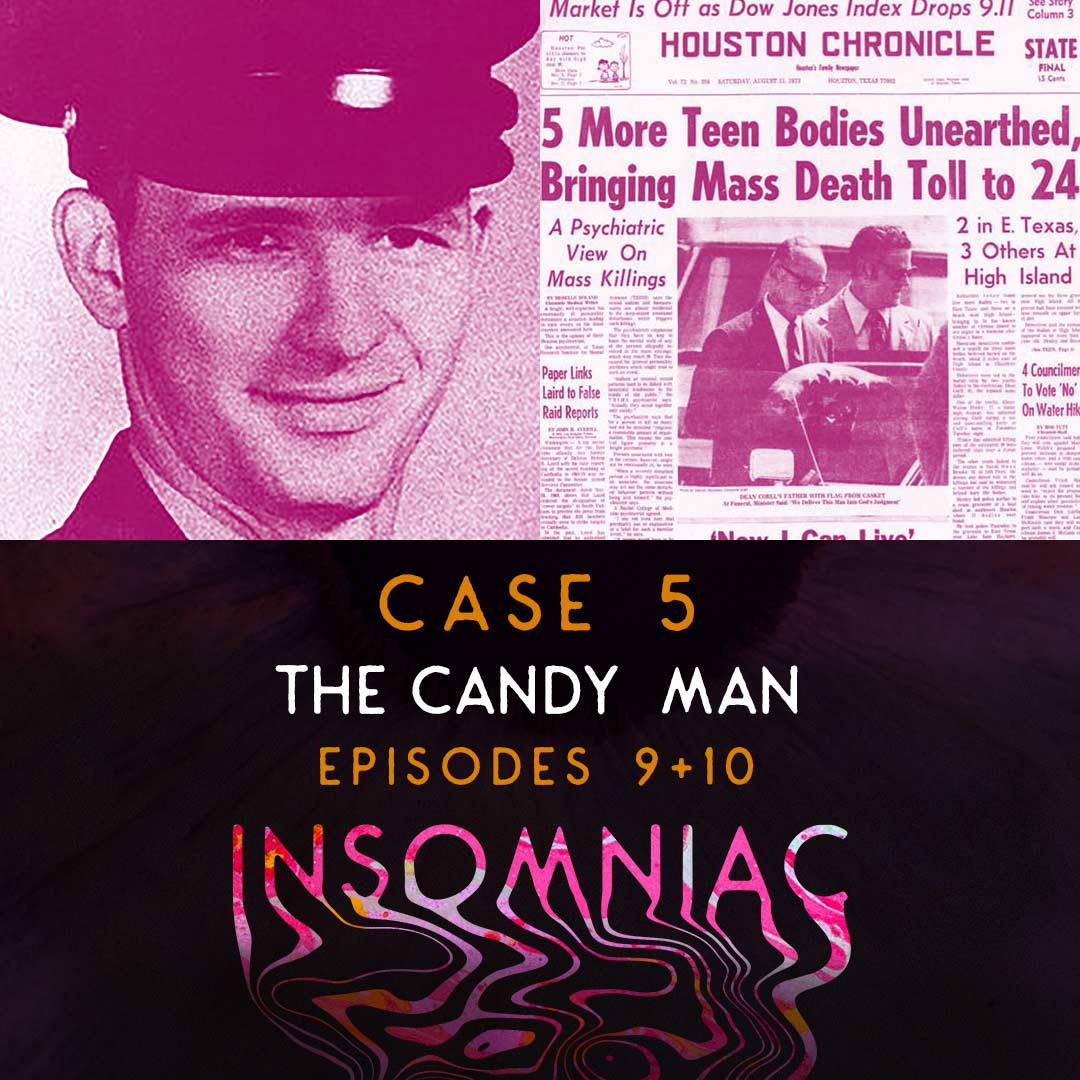case 2
Arthur Shawcross
The Genesee River Killer
The Genesee River Killer
Search for info about The Rochester Strangler, and you’ll be subjected to a sordid tale that involves child sexual abuse, wartime atrocities, brutal murders, body mutilation and even cannibalism. There’s no denying that Arthur Shawcross was a real-life monster; however, there are a few unique details surrounding this case that somehow make his horrific crimes feel even more despicable and senseless than other serial killings you’ve read about. For one, Shawcross is known for having two distinct active killing stages — yet those stages were 15 years apart. We’ll tell you why. Another is a legal agreement, one that was made in New York in 1972, that would eventually cost the lives of 12 additional women — all at the hands of Shawcross. We’ll tell you how that victim count could have been stopped at just two.
Part 1
Part 2
I should . . . have an electrode placed in my head to stop my stupidness or whatever. I (sic) just a lost soul looking for release of my maddness (sic). Please God, let someone help me.
Arthur John Shawcross, handwritten account, 1990
Despite the warnings of prison psychiatrists, after less than 15 years behind bars, social workers and prison staff members incorrectly determined Shawcross was no longer dangerous and granted him early parole in April of 1987.
His early release from prison or even the fact he was even being released at all was a mistake that would only be amplified over the next 3 years.
Scott Benjamin, Host
Transcripts
Part 1
Payne Lindsey: The views and opinions expressed in this podcast are solely those of the authors and participants, and do not necessarily represent those of iHeartMedia, Stuff Media, or its employees. Listener discretion is advised.
From iHeartRadio and TenderfootTV, Monster Presents: Insomniac.
Scott Benjamin: 00:25 If you’ve never heard of Arthur Shawcross, I think you’re going to find him to be one of the most revolving characters you’ve heard about in a long, long time. His crimes span decades. His punishments along the way were far too light for the atrocities that he committed. And maybe the worst detail of all, there were children involved. For me, the stories that involve kids always seem to be the hardest ones to understand and they’re definitely among the hardest to ever forget.
Scott Benjamin: 01:00 After listening to this show I think you’ll find yourself wanting to forget Arthur Shawcross too. I wish I could get him out of my head, but so far that’s been impossible. I’m Scott Benjamin and everything I’m about to tell you is real. This is Insomniac.
Scott Benjamin: 01:30 The date was January 3rd, 1990 and police were searching North Hampton Park, located 16 miles east of Rochester, New York after a missing woman’s clothing and ID card had been found in the area. Just minutes into a helicopter surveillance flight New York State Troopers had already spotted something. They saw a woman’s body partially clothed face down on the surface of the ice underneath a bridge that crossed over Salmon Creek. They didn’t know it yet but they had just stumbled across the frozen, mutilated body of yet another missing woman, not even the one they were initially searching for. It was a prostitute named June Cicero, age 34, and she had been missing for more than two weeks.
Scott Benjamin: 02:21 Remarkably, at that very moment a car was parked on the same bridge and the driver had his door open with his legs outside of the vehicle. It was difficult for the troopers to determine exactly what he was up to from high above. They appeared to be either be urinating on the bridge or possibly masturbating. As soon as he noticed the helicopter, the man threw something out onto the ice and drove away. But the State Troopers followed his every move from the air and called in ground units to tail him into town.
Scott Benjamin: 02:56 Within minutes, he was picked up, taken to the nearby [Rockport 00:03:01] Police barracks, questioned, photographed and then released. Overnight authorities kept the suspects home under surveillance while detectives dug up every bit of information they could about the man they found just a few feet away from the frozen body on the ice. What they would discover that evening, and in the days and months to follow, would horrify every officer on the force and, later, infuriate the entire community of Rochester, New York.
Scott Benjamin: 03:41 We’re going to take a closer look at the case of the Rochester Strangler or, as it’s sometimes called, the Case of the Genesee River Killer. But this story, to have the full impact, you need to know that it’s considered normal for a serial killer to experience a cooling off period between their deadly attacks. In fact, that’s one of the key behaviors that set serial killers apart from other types of killers. Spree and mass-murders claim all of their victims at once, all in the same day, and often all in the same location with one violent outburst. And serial killer follows a different pattern, one that includes an active period when the homicide happens, followed by an emotional cooling off period when the killer returns to his or her normal life, followed by another active period, and so on.
Scott Benjamin: 04:38 If the result is a body count that rises above three, you have a serial killer on your hands. Typically, that cooling off period is a matter of days, weeks, or sometimes months, but in the story I’m going to share with you today the killer deviates in these norms and takes an unusually long cooling off period between his first and second series of victims, 16 years, in fact. He also completely changes the target of his crimes between the second and third victims. It’s very rare for a serial killer to change his method of operation but he does and you’ll find out why.
Scott Benjamin: 05:22 But we’re going to start in early-1972 in a small Upstate New York city of Watertown where an unspeakable tragedy was about to strike the community. It was the spring of 1972 and Arthur John Shawcross, age 26, was an employee with the Watertown Public Works Department. He had just married his third wife, Penny, in late-April. Shawcross had only recently been released from the state prison after serving time for burglary and arson. He had set fire to a paper mill in April of 1969, and then to the cheese company that he worked for in September of the same year.
Scott Benjamin: 06:13 While serving his prison sentence, Shawcross had spent just a few months at the Attica Correctional Facility before being transferred to Auburn Prison in the summer of 1970. Later that same year, on November 4th, 1970 an inmate riot broke out in Auburn. 30 guards were seized as hostages and the inmates had control of nearly the entire prison. The riot only lasted one day, but it took a combined total of more than 600 State Troopers, additional prison guards and sheriff’s deputies to regain control. When the situation had cooled down it was revealed that inmate Arthur Shawcross had saved the life of a prison official during the riot. With this, he was granted early parole and was released after serving just 22 months of a five-year sentence.
Scott Benjamin: 07:08 So in October of 1971, Arthur Shawcross was a free man and he returned to his daily life in Watertown, New York. Had the parole board known what was about to happen in that small, charming city over the next year, they never would have let him out early.
Scott Benjamin: 07:40 Shawcross enjoyed fishing, and due to this hobby he spent a lot of his free time in and around the surrounding creeks and rivers, mainly the Black River, the waterway that runs right through the middle of town. As a result, he often shared the riverbanks with the children of Watertown. One young boy, Jack Owen Blake, age 10, became one of Arthur’s favorite fishing buddies. On May 7th, 1972, just seven months after Shawcross was released from prison, Jack Blake went missing. The Blake boy’s body wasn’t initially found but suspicion immediately fell on Arthur Shawcross. Arthur and Jack, along with Jack’s younger brother, had been fishing together just days before he disappeared.
Scott Benjamin: 08:35 Shawcross repeatedly denied any knowledge of the boy’s disappearance and says there was no evidence against him, including no body. He remained a free man. Four months later, on September 2nd, 1972, and while the search for Jack Blake was still on, it happened again. Another child went missing in Watertown.
Scott Benjamin: 09:07 Lots of us tell a variety of lies on a daily basis. Most are small but, occasionally, a few whoopers too. We intentionally make false statements to others to ease social interactions, protect someone’s feelings with a small white lie, or use a lie to simply avoid the unpleasant consequences of telling the truth. Pathological lying, on the other hand, is when the behavior becomes compulsive or habitual. It’s when a person lies consistently for absolutely no personal gain, other than maybe to bolster their own character, regardless of how unfounded those claims may be. Pathological liars typically try to present themselves in a favorable light, or as the hero, not the bad guy of the story.
Scott Benjamin: 09:59 Pathological lying was one of many issues Arthur dealt with throughout his life. While in prison he self-reported sexual abuse between himself at a young age, and his mother, his aunt, his sister and a couple of his cousins. Later he would claim, as an adolescent, he had sex with a variety of barnyard animals too. Each of the accused family members has denied all of Arthur’s sexual abuse allegations and not one instance was ever proven to be true. What we do know of his past is somewhat troubling.
Scott Benjamin: 10:38 Arthur was a bed-wetter until the age of nine, and his mother repeatedly shamed him for that. We also know that he was sexually excited by lighting fires and that he liked to torture and kill small animals, including fish, cats, squirrels and birds. That’s all three points of the Macdonald Triad, a set of three factors that suggest future violent tendencies and serial offenses from an individual if three, or any combination of two are present together, bed-wetting, fire-setting and cruelty to animals. Again, Arthur exhibited all three traits. He also had at least three known closed-head brain injuries between the ages of 16 and 22.
Scott Benjamin: 11:30 At the age of 16 he was in the head with a discus and spent several hours unconscious. At age 18 he was struck in the head with a sledgehammer. Again, he was unconscious for several hours. And at age 22, while he was in the Army, he fell from a 40-foot ladder striking his head and rendering him unconscious once again for several hours. Years later, an MRI scan of Arthur’s brain would show that he had developed a cyst in one temporal lobe and residual scarring on both frontal lobes from the discus and sledgehammer incidents.
Scott Benjamin: 12:13 He dropped out of school after his second failed attempt at ninth grade and eventually was drafted in the Army at age 19 during the Vietnam War. Arthur also bragged about his tour of duty and his battlefield heroics in Vietnam, greatly exaggerating the role he played and even admitting to several grotesque wartime atrocities. He bragged about solo jungle missions where he killed women and young girls, torturing them, raping them, cutting their heads off and nailing them to trees, or sticking them on posts and then cannibalizing parts of their bodies. There’s no proof any of this ever happened.
Scott Benjamin: 12:55 He claimed to be an expert sniper during the war and that he could fashion a rifle silencer out of a rubber nipple from a baby’s bottle. He also claimed battlefield kill count of 39 enemy soldiers. Yet, according to Arthur’s commanding officers, the truth is, Arthur was a supply clerk and never saw combat.
Scott Benjamin: 13:19 In the years to follow, back at home in Upstate New York, Arthur would eventually mutilate several of his victims. And while occasionally there were body parts missing, it was impossible to prove that he ever consumed any of the missing parts, including Jack Blake’s heart and genitals and, much later, the vaginas of three of his female victims.
Scott Benjamin: 13:49 The date was September 2nd, 1972, just four months after the disappearance of Jack Blake, and there was another child missing in Watertown. This time it was Karen Ann Hill, age eight who was visiting with her mother for the Labor Day weekend. The Watertown police were now searching for two missing children. They found Karen Hill first. Her lifeless body was discovered under a bridge. She had been raped, mutilated and strangled. Mud, leaves and other debris had been forced down her throat and inside her clothing. Once again, Arthur Shawcross, now age 27, was an immediate suspect.
Scott Benjamin: 14:42 The police investigation revealed that he and Karen Hill had been seen together on the day of her disappearance and neighbors reported that Arthur was seen eating ice cream on the bridge right near where the body was discovered. Arthur, again, denied any involvement in the disappearance of the child. But after a full day of police interrogation, he finally cracked.
Scott Benjamin: 15:09 With his defense attorney present, Shawcross decided that he had had enough and asked police, “What would happen to me if I told you something?” In the hours that followed he admitted to killing Karen Hill, but he also let them know that he had additional information to share. He could lead them to the body of the still missing Blake boy, if they were willing to make a deal.
Scott Benjamin: 15:39 Shawcross told them exactly what they wanted to know. Four months earlier it was he who had lured 10-year-old Jack Blake into the woods, stripped him naked, sexually assaulted him, and then strangled him to death. As part of a plea bargain, in exchange for showing the police where the body of Jack Blake could be found, the authorities lessened the charge against Shawcross to manslaughter for the rape and murder of Karen Hill, and all other charges were dropped entirely. He would not be charged in the rape or murder of Jack Blake.
Scott Benjamin: 16:17 For his crimes, Arthur Shawcross was sentenced to just 25 years in prison with the possibility of early parole. And while that already seems like a light sentence for murdering two children, it gets even worse. Despite the warnings of prison psychiatrist, after less than 15 years behind bars social workers and prison staff members incorrectly determined that Shawcross was no longer dangerous and granted him early parole in April of 1987.
Scott Benjamin: 16:54 Why did the prison psychiatrist advise against his release? Well, one reason was that Shawcross had revealed that he had returned several times to the site where he dumped Jack Blake’s body to have sex with the corpse. He also confessed to removing the boy’s heart and genitals and eating them. His early release from prison, or even the fact that he was being released at all was a mistake that would only be amplified over the next three years.
Scott Benjamin: 17:38 My nightmares, yeah, I’m still having them.
Scott Benjamin: 17:42 I had another pretty disturbing dream this weekend.
Scott Benjamin: 17:46 The last one was just a few days ago around 3:00 AM. It was another really, really violent dream. I’m being chased. I was laying facedown, yelling and violently kicking the mattress as hard and fast as I could. My wife was startled, terrified, and rightfully so. It’s clearly someone who’s serious about catching me, serious … There’s a reason they want me.
Scott Benjamin: 18:18 In our moonlit bedroom it looked like someone was attacking me on my side of the bed. Someone was. By the next morning, the only lasting memory I had of that evening’s nightmare was of someone endlessly chasing me. As we raced up a very steep set of stairs, almost as steep as a ladder, he reached out to grab my ankles and that’s when I turned and began kicking him in the head.
Scott Benjamin: 18:45 It was that terrifying moment when the pursuer catches me. Like, “This is it. I’ve got to fight, otherwise I’m dead.” It’s going to be a battle to the death. The scary thing about this is, I, oh boy, I didn’t stop. Over and over again, as hard as I could, I didn’t stop. I just kept going, and going, and going until the person’s practically unrecognizable.
Scott Benjamin: 19:19 Was it Arthur chasing me? I don’t know. I can’t say for sure it was him but I can tell you there was no more sleep for me that night.
Scott Benjamin: 19:30 I guess you can understand why I didn’t want to record that with my family around me, or near me. So I’m confessing to this, even though it’s something that never really happened and I got to deal with that. That’s about it for now.
Scott Benjamin: 19:53 I hope he doesn’t haunt your dreams the way he has mine.
Scott Benjamin: 20:02 A common trait among captured serial killers is that, even though they’re locked behind bars, they want to believe that they’re still somehow in control of what’s happen outside of the prison walls. Arthur Shawcross was no different. We’ve established his tendency to lie about nearly all aspects of his life, a pattern that he continued in prison but he did so in a somewhat puzzling way. He attempted to manipulate all of his interviewers, detectives, doctors, anybody that would listen to him by changing his story.
Scott Benjamin: 20:43 The way he answered questions would vary greatly based on who he was talking to. If it was a male interviewer, Arthur would play up his heroic, but completely fictional, actions on the battlefield in Vietnam. If it was a female interviewer, Arthur would go into long, detailed descriptions of his mutilation killings and described to them how much he enjoyed removing parts of his victims, and then how much he enjoyed eating those parts. And if he detected a tiny bit of sympathy from his interviewer, his narrative always switched over to his alleged, but never proven, claims of sexual abuse at the hands of his mother and aunt. He would add graphic details to his stories of abuse to see if he could illicit an even greater sympathetic response from across the table.
Scott Benjamin: 21:35 Again, manipulative behavior isn’t necessarily surprising from a serial killer and it was always fairly easy for those Arthur spoke to to see right through his made up stories. They knew he was a liar and he was never going to change.
Scott Benjamin: 22:00 How Arthur Shawcross dealt with his early release from prison and how he chose to fill his free time doesn’t even begin to tell the story. He would undergo an extraordinary physical transformation as he struggled to find a new home and, unfortunately, an all new group of victims. Next time on Insomniac.
Speaker 3: 22:25 Insomniac is a production of iHeart Radio and Tenderfoot TV, written and hosted by Scott Benjamin and produced by Miranda Hawkins, Alex Williams, Matt Fredric and Josh Thane. Music composed by Makeup and Vanity Set, and cover art by Trevor [Iler 00:22:41]. Follow in Twitter and Facebook at Insomniac Pod, on Instagram at Insomniac Podcast, and at our website, InsomniacPodcast.com.
Speaker 3: 22:51 For more podcasts from iHeart Radio, visit the iHeart Radio app, Apple Podcasts, or wherever you listen to your favorite shows.
Part 2
Payne Lindsey: The views and opinions expressed in this podcast are solely those of the authors and participants and do not necessarily represent those of iHeart media, Stuff Media or its employees. Listener discretion is advised.
From Iheartradio and Tenderfoot TV, Monster presents INSOMNIAC.
Scott Benjamin: 00:25 I don’t know for sure, but I’m going to wager a guess that most of you had never seen a barn fire in person before. It’s something that I’ve witnessed several times in the past and strangely enough, I had a dream about a barn fire last night.
Scott Benjamin: 00:39 I don’t know if I would call it a nightmare, but it was definitely a vivid, realistic dream that made me think of being a young boy again in northern Indiana. I was standing there in my footie pajamas, watching a structure fire that had no hope of being put out before the entire building was consumed.
Scott Benjamin: 00:55 It took me right back to when I was five or six years old. I remember driving miles and miles behind fire trucks and then standing out in the cold air of a mid-western night. Barns burning incredibly fast, and incredibly hot. Usually by the time the fire trucks arrived, it was too late to save the building.
Scott Benjamin: 01:14 They were just there to knock down the flames and prevent it from spreading to the farmhouse, or other nearby buildings. Sometimes, the farmers were lucky enough to get the animals out. Sometimes, they weren’t so fortunate. But with a loft full of hay fueling the fire, there was usually no hope, and that always made it even more tragic.
Scott Benjamin: 01:34 Sometimes, there was a lot of confusion on the ground. Other times everything seemed eerily calm as the firemen went about their business. It all played out right in front of us. It was exciting and terrifying. Beautiful, yet terrible, all at once.
Scott Benjamin: 01:54 I’m Scott Benjamin. And everything I’m about to tell you is real. This is, Insomniac.
Scott Benjamin: 02:16 It was April of 1987, when Arthur Shawcross, now aged 41, was out of prison and on parole once again. This time his appearance was dramatically different. He was no longer the relatively fit and trim six foot tall, ex-military man that went to prison in 1972. He now weighed 300 pounds, and it wasn’t muscle.
Scott Benjamin: 02:44 His third wife, Penny, had divorced him in 1975, just three years into his prison term, but he already had another girlfriend waiting for him. Her name was Rose, and she had been Arthur’s is prison pen pal.
Scott Benjamin: 03:03 Life on the outside was different for Arthur this time. For one, he and Rose, couldn’t find a place to live. It wasn’t that there were no houses for rent, or apartments available. The problem was that no community wanted a convicted child rapist and murderer moving in.
Scott Benjamin: 03:24 Arthur couldn’t return to Watertown for obvious reasons. And since this post-prison relocations were well publicized, in the first three communities he tried, there was a strong objection to his arrival.
Scott Benjamin: 03:40 First they tried Binghamton, New York. Then Del Ray. Then Fleischmanns. But in every case he and Rose were run out of town. A senior parole board officer finally decided it was time to try something different.
Scott Benjamin: 03:58 They made the unfortunate decision to seal Arthur Shawcross’s criminal records, and then moved him 250 miles away into an apartment in the city of Rochester, New York without telling the members of the community, or the authorities. In other words, no one knew who he was, and his violent sex offender past was now invisible.
Scott Benjamin: 04:30 Arthur soon found a job to pay the bills. Working night shift, chopping and packaging salads in boxes for a local food service company. He and Rose were married in the summer of 1987.
Scott Benjamin: 04:44 By Christmas of the same year, Arthur, now aged 42, was already having an affair with an older woman named, Clara Neal. She was 56. By the spring of 1988 Shawcross’s typical behavior was so erratic, that neither of the two women he was involved with noticed anything unusual, when he began staying out all night, and using his mistresses borrowed car, a 1984 blue Dodge Omni, to cruise for prostitutes in the Industrial Area near the Genesee River. That’s where he found his first adult victim, a prostitute by the name of Dorothy Blackburn, age 27.
Scott Benjamin: 05:29 The agreement the two made was for mutual oral sex for $30. Years later. Shawcross would claim that during the encounter, Dorothy bite his penis, drawing blood and infuriating Shawcross to the point of violent retribution. In turn, he bit a chunk of flesh out of her vagina, and then choked her until she was unconscious.
Scott Benjamin: 05:55 He then drove her lifeless body out to one of his favorite fishing spots. The bridge over the Salmon River in North Hampton Park, and dropped her into the cold water below. Her remains wouldn’t be found for nearly a week.
Scott Benjamin: 06:11 She was well preserved in the icy water, but the river had also removed any evidence that her killer might’ve left behind, aside from the deep bite marks around her genitals.
Scott Benjamin: 06:23 The community of Rochester, New York didn’t know yet, that Dorothy Blackburn’s murder was just the first of what would be many, many more in Arthur’s second series of victims.
Scott Benjamin: 06:36 It would be almost four months before Arthur would strike again. It was early July, 1988. Now that he was ready, he returned to his favorite hunting ground, a stretch of road called Lyle Avenue in downtown Rochester. It was there that he found another prostitute, Anna Marie Stephan, age 28.
Scott Benjamin: 07:00 A deal was made between the two. Sex for cash. They headed down to the banks of the Genesee river, in the dark privacy that location provided. But when Shawcross was unable to perform sexually, he claims Anna Marie made fun of him. He punched her to the ground.
Scott Benjamin: 07:19 In the darkness, she crawled into the river to escape. But he went in after her, grabbed her by the throat, and held her underwater until she drowned. This time, he simply let the body float downstream instead of trying to hide it.
Scott Benjamin: 07:39 She was discovered two months later. Somehow, Arthur resisted the urge to kill for a full year, before taking his third victim in Rochester. This time it was a homeless woman, Dorothy Keeler, age 59.
Scott Benjamin: 07:56 Dorothy was working as a waitress in a diner Shawcross occasionally visited, and she and Arthur were having an affair. It was July 29th, 1989, and the two would spend a lazy afternoon together, fishing and having sex on Seth Green Island, in the middle of the Genesee river.
Scott Benjamin: 08:17 At some point, the conversation grew serious and Dorothy threatened to reveal herself to the other two women in Shawcross’s life. His wife rose and his mistress, Clara. Arthur and Dorothy argued, he flew into a rage, picked up a heavy log, and he beat Dorothy to death. He then concealed her body under a fallen tree before heading home for the evening.
Scott Benjamin: 08:45 Later, Shawcross told police that he returned to Keeler’s corpse, months afterward to remove her skull. He threw it into the river, and it was never found. What was left of her body was discovered by fisherman on October 21st, 1989, nearly three months after she went missing.
Scott Benjamin: 09:11 Just six days after Dorothy Keeler was found, on October 27th, 1989, the discarded body of yet another local sex worker, Patricia Ives, age 25, would be uncovered at a construction site. She had also been strangled.
Scott Benjamin: 09:29 A little more than two weeks later, the bodies of to Rochester prostitutes were found on the same day, November 15th, 1989. Frances Brown, age 22, and Kimberley Logan, age 30. They’d been taken just days apart in early November.
Scott Benjamin: 09:49 Kimberly Logan was found to have leaves stuffed down her throat to silence her during her attack. Similar to Shawcross’s second victim, eight year old Karen Hill. Arthur also used this tactic to silence the animals he killed when he was much younger.
Scott Benjamin: 10:07 Just days later on Thanksgiving Day, 1989, the body of another local woman was found underneath the blanket and a pile of brush. It was the body of June Stott, age 30. She had been missing for exactly one month. She was not a prostitute or a drug user. In fact, Stott was a friend of Rose and Arthur Shawcross, even an occasional guest at their home.
Scott Benjamin: 10:37 Similar to the other recent victims, June Stott, had been strangled to death. Unlike the other adult victims to date however, her body had been mutilated. She was sodomized after she was killed. She had been gutted from her genitals to her throat, and her vagina had been cut and removed. Arthur would later claimed that he had eaten that part of her, along with some internal organs.
Scott Benjamin: 11:03 The killer’s violence, as well as the frequency with which he was taking his victims had now escalated considerably. It was impossible for the police and the press to ignore the similarities among the recent slayings.
Scott Benjamin: 11:19 And while the detectives continued to comb through the criminal records of the violent offenders that might be living in the area, Arthur Shawcross’s is sealed criminal records meant that he didn’t show up on any police searches. He remained invisible.
Scott Benjamin: 11:35 As a result of interviews with the local prostitutes, the authorities were now canvassing the street corners and bars looking for a suspicious man that several of the ladies had come to now as, Mitch. He was a regular customer on Lyle Avenue. Some of them knew both from experience and word of mouth that Mitch, was not only capable of violence, but he was also seen with several of the now missing women.
Scott Benjamin: 12:03 What the cops didn’t realize at the time was that they were closer than ever to the mysterious Mitch, and they were unintentionally giving him inside information, that allowed him to continue his deadly attacks virtually unchallenged.
Scott Benjamin: 12:29 Arthur and Rose Shawcross lived at 241 Alexander Street in Rochester, New York. There was a Dunkin’ Donuts located just down the block from their home on the corner of Alexander Street and Monroe Avenue, about a four minute walk from door to door. Arthur was a regular customer there.
Scott Benjamin: 12:49 I know it sounds cliche, but that donut shop is where the police would often gather. The place where they felt like it was safe to let their guard down a bit. And of course, the shoptalk often turn to what was happening in the Genesee River killer case.
Scott Benjamin: 13:05 Arthur was routinely present for these discussions. Between his deadly attacks, Arthur would learn exactly what the police were discussing. The leads they were chasing down, and in general, how close they were to capturing, well, him the killer. The whole thing was a sort of cat and mouse game, where the mouse, Arthur, had the inside line and exactly what the cat, the Rochester police, were up to.
Scott Benjamin: 13:36 Years after his arrest, Arthur was asked about his donut shop conversations with the police. He attributed to his ability to get away with being so close to his pursuers without suspicion, to being well-groomed and well-dressed, including wearing shiny shoes. A trait Arthur claimed the police liked about him.
Scott Benjamin: 13:58 At the donut counter. He played the role of a concerned citizen, instead of the sort of individual you might suspect would be out on the streets killing prostitutes at night. Because Arthur had gained their trust, he was occasionally given some friendly inside information about the stake-outs. Where the decoy prostitutes were located, and the investigation in general, straight from the police work in the case.
Scott Benjamin: 14:26 Well, this is a fairly rare situation. It’s not the first time we’ve heard a similar story. Edmund Camper, is an example of another serial killer who befriended the local police to gain inside information on the investigation of the murders he was carrying out. He hung out with police in a bar called, The Jury Room, across the street from the Santa Cruz County Courthouse in Santa Cruz, California.
Scott Benjamin: 14:53 Similar to Shawcross, the police came to know Camper, as a friend. One of the officers even once gave him a set of real police handcuffs as a gift. He occasionally used them in his killings, if the girl he abducted was putting up a struggle.
Scott Benjamin: 15:17 It was late 1989. Arthur Shawcross was 44 years old, and his body count continued to steadily grow. Seven missing women had already turned up dead, and there would be numerous more before it was all over.
Scott Benjamin: 15:34 Just four days after the Thanksgiving Day discovery of June Stott’s body, another Shawcross victim was found. This time it was Elizabeth Gibson, age 29. She was a prostitute, strangled to death just like the others. However, her body was dump in nearby Wayne County, New York, instead of Rochester. As Arthur felt the police were getting a little too close for his comfort level.
Scott Benjamin: 16:03 Next, it was the body of 20 year old Felicia Stephens, found on New Year’s Eve, 1989. Murdered just three days after Christmas, she was Arthur’s final kill, but she wouldn’t be the last victim recovered. There were still missing women to be found.
Scott Benjamin: 16:23 Just three days later, on January 3rd, 1990, the body of June Cicero was recovered as a result of the New York State trooper helicopter surveillance flight. Those on the scene would note that her body had been mutilated in a manner similar to two earlier victims.
Scott Benjamin: 16:40 At some point after her death, the killer had returned to June Cicero’s frozen body to remove her vagina with a small hand saw. This was the same surveillance flight, that also exposed Arthur Shawcross, parked on the bridge directly above June Cicero’s frozen corpse.
Scott Benjamin: 17:03 When the authorities finally caught up to, and questioned him on that first day, Arthur reluctantly told them he was previously found guilty of manslaughter in Watertown in 1972, but he denied any knowledge of the recent Rochester murders. Since he wasn’t under arrest, he was questioned a while longer, photographed and released. Kept under constant surveillance of course, but released.
Scott Benjamin: 17:32 Overnight, the detectives did their homework. Right away they found a sealed criminal file, and a link to some critical physical evidence in the case. They investigated Arthur’s place of employment, a food service company called G & G Cheese, and found that the company used a brand of handy wipes that matched those found at two of the crime scenes. And they were the same wipes found in Shawcross’s home too. And from there, the rest of the missing pieces started coming together.
Scott Benjamin: 18:07 One point that really grabbed the investigator’s attention, was when Arthur started telling them about his favorite fishing spots. All the places he preferred along the river coincided with where the bodies of the missing prostitutes were found.
Scott Benjamin: 18:22 Just two days after their initial contact with Shawcross, and with around the clock investigation into his background and activities, including several hours of conversation with him personally, the police had enough evidence to arrest him and charge him with the murders.
Scott Benjamin: 18:38 The date was January 5th, 1990. Arthur knew it was over. He asked to be allowed to speak with his wife, Rose, and said that if he could just speak to her first, he’d tell them everything they wanted to know. And that’s what he did.
Scott Benjamin: 18:58 Throughout his lengthy confession to the authorities, Arthur showed no sign of emotion, no remorse at all. When asked why he did it, he coldly stated that he was just taking care of business.
Scott Benjamin: 19:11 With the signed confession in hand. The authorities allowed Arthur to lead them to the bodies of two missing women, they hadn’t yet recovered. Maria Welch, aged 22, who had been missing since early November, 1989, and Darlene Trippi, aged 32, who had been missing since December 15th. It wasn’t a surprise that both women had been strangled to death.
Scott Benjamin: 19:39 When it was all over, the number of women who lost their lives at the hands of Arthur Shawcross in Rochester alone, was 12. When you add the two children he killed in Watertown in 1972, Jack Blake and Karen Hill, the grim total grows to 14.
Scott Benjamin: 19:59 Since all the victims were killed in Monroe County, New York, with the exception of Elizabeth Gibson, who was killed in nearby Wayne County, the Monroe County trial was held first. The court proceedings lasted nearly three months, with all of Rochester, keeping watch.
Scott Benjamin: 20:33 It wasn’t until years later that I realized this siren chasing was a common behavior in my family. We always watch from a safe distance away, maybe a few hundred yards or so. Usually we were close enough to smell the smoke and even feel the heat.
Scott Benjamin: 20:50 Sometimes, we’d see the whole structure collapse onto itself. That always produced what seemed like a million glowing numbers shooting upwards, along with the blinding red and orange flames, and a tower of the thickest black smoke you can imagine billowing into the sky.
Scott Benjamin: 21:06 I remember it was a thrill to be so near the action, but it was also scary. My dad was always a siren chaser. He couldn’t resist getting close to the scene of an accident, a fire, an arrest in progress, anything really. It was a behavior he learned from his mother, my grandmother. Lately I’ve began to wonder if it was a behavior that she had learned from her father, my great grandfather.
Scott Benjamin: 21:34 They lived in a small town, so whenever the sirens began, my grandmother would load up the kids and go see what she could. My dad was the same way when I was growing up. And today I find it difficult to resist turning the car around and see what’s happening, if I see emergency lights. I can’t believe that it took me so long to realize that I’m the product of at least three, possibly four generations of siren chasers. That explains a lot.
Scott Benjamin: 22:12 In the United States, broadcasting and photography of the court proceedings is allowed in some courtrooms but not others. In 1979, the eyes and ears of the public were focused on the nationally televised trial of serial killer, Ted Bundy. In 1992, it was Jeffrey Dahmer. In 1993, the Menendez brothers. In 1995, it was the OJ Simpson trial.
Scott Benjamin: 22:40 It’s clear that television viewers enjoy watching high profile criminal court cases play out in front of them, on live television. While the 1990 trial of Arthur Shawcross might’ve had a somewhat limited audience due to its local coverage, rather than national coverage, the citizens of Rochester were more than willing to watch.
Scott Benjamin: 23:03 The New York Times ran an article about the televised Shawcross trial on December 2nd, 1990. It said, “Like a moth drawn to a flame, Rochester, a city of 241,000 people has been both repulsed and riveted by the proceedings in the teak paneled second floor courtroom of the Monroe County Public Safety Building.” For more than 10 weeks, the residents of Rochester, and the surrounding areas tuned into witness the courtroom drama and theatrics of the Shawcross case.
Scott Benjamin: 23:42 It was television that was difficult to watch at times, because it was a lurid tale, that included details of child sexual abuse, beastiality, wartime atrocities, murder, reincarnation, corpse mutilation, and claims of cannibalism.
Scott Benjamin: 24:00 Add into the public’s outrage, was the now widely known fact that Shawcross’s criminal record had been sealed, and that a convicted child rapist and killer had been moved into Rochester without alerting members of the community, or the authorities.
Scott Benjamin: 24:17 They also saw him plead not guilty by reason of insanity. Well, his defense attorney showed the courtroom videotapes of a supposedly hypnotized Shawcross, as he claimed to be taken on one of his many multiple personalities. Air Amaz, a reincarnated 13th century Cannibal from England, who Arthur claimed taught him to eat human flesh.
Scott Benjamin: 24:39 Well, the tapes were shown and throughout the entire trial, Shawcross set perfectly still in the courtroom, head down, shoulders slumped, showing no emotion at all. In the end, the jury didn’t believe Arthur was possessed and much to everyone’s relief, he was found guilty of 10 counts of second degree murder.
Scott Benjamin: 25:04 With a sentence of 25 years for each count, Arthur Shawcross, now aged 45, would be behind bars for the next 250 years with no chance of parole. The following year when the Wayne County trial was held, Shawcross simply plead guilty to the second degree murder of Elizabeth Gibson, and received yet another life sentence.
Scott Benjamin: 25:35 Arthur was incarcerated at the Sullivan Correctional Facility, a maximum security prison for male prisoners in Fallsburg, New York. In prison, Arthur was an outsider, a pariah. With very few exceptions, he was avoided, ignored and often threatened by nearly every other inmate in Sullivan. They deemed him the lowest of the low. A pedophile or rapist, and a serial killer of women and children.
Scott Benjamin: 26:06 Soon after his conviction, Arthur was divorced from his fourth wife, Rose. She served him with papers on his 49th birthday, in June of 1994, though Shawcross would pass away less than three years later, in the spring of 1997. Arthur was now legally free to marry his former mistress, Clara. And did so in a ceremony held in the prisons visiting room on July 10th, 1997.
Scott Benjamin: 26:34 She was his fifth wife. But his time in prison for this, his second series of murders would be only slightly longer than a sentence for child killings back in 1972. On November 10th, 2008, just shy of 18 years after his trial and conviction, Arthur Shawcross, now aged 63, died of a pulmonary embolism.
Scott Benjamin: 27:00 He had complained of leg pain earlier in the day, and by the time he was transferred to the Albany Medical Center later that evening, it was too late. Arthur Shawcross was dead. The citizens of Upstate, New York, breathed a collective sigh of relief.
Scott Benjamin: 27:18 Well, the best case scenario would have been to avoid even a single murder. That might not even have been entirely possible in this case. Throughout his entire life, whenever he wasn’t in prison, Arthur Shawcross was killing. Whether it’s when he was a kid torturing and killing small animals. As a young adult, torturing and killing children, or as a middle aged man, strangling and killing sex workers.
Scott Benjamin: 27:47 If Arthur Shawcross had not been granted the plea bargain deal in 1972 after the Watertown child killings, he would’ve been locked up for life. The body count would’ve stopped at just two, instead of reaching 14. Two dead children are bad enough. But in this case, a series of poor decisions led to the deaths of 12 additional women in Rochester, New York.
Scott Benjamin: 28:17 In 2011, in a South Georgia college town, a bad neighbor was lurking near campus. People find him creepy, antisocial, but he turned out to be far worse than anyone ever expected. A predator who selected the woman next door as his prey.
Scott Benjamin: 28:37 I’ll prove that you never know who might move into your neighborhood. And you certainly have no idea what they’re up to, or capable of behind closed doors. Next time, on Insomniac.
Speaker 3: 28:57 Insomniac, is a production of iHeartRadio and Tenderfoot TV. Written and hosted by Scott Benjamin, and produced by Miranda Hawkins, Alex Williams, Matt Frederick and Josh Thane. Music composed by Makeup and Vanity Set, and cover by Trevor Eiler.
Speaker 3: 29:15 Follow on Twitter and Facebook @insomniacpod, on Instagram @insomniacpodcast. And on our website, insomniacpodcast.com. For more podcasts from iHeartRadio, visit the iHeartRadio app, Apple podcasts, or wherever you listen to your favorite shows.
More Episodes, More Cases
Case 3 | Part 1
The Creepy Neighbor

Case 3 | Part 2
The Creepy Neighbor

Case 4 | Part 1
The Meanest Man in America

Case 4 | Part 2
The Meanest Man in America
